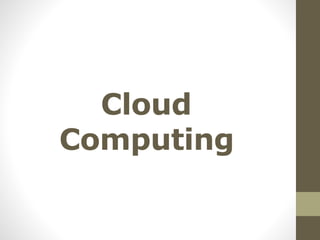
Cloud computing
- 2. Basic Definition • When we store your photos online instead of on your home computer, or use webmail or a social networking site, we are using a “cloud computing” service. If we are an organization, and you want to use, for example, an online invoicing service instead of updating the in-house one we have been using for many years, that online invoicing service is a “cloud computing” service. Basically it is on network sharing of resources.
- 3. Deployment of cloud services: • Generally speaking, services provided by a public cloud are offered over the Internet and are owned and operated by a cloud provider. Some examples include services aimed at the general public, such as online photo storage services, e-mail services, or social networking sites. However, services for enterprises can also be offered in a public cloud. • In a private cloud, the cloud infrastructure is operated solely for a specific organization, and is managed by the organization or a third party. • In a community cloud, the service is shared by several organizations and made available only to those groups. The infrastructure may be owned and operated by the organizations or by a cloud service provider
- 4. Service Models • Infrastructure as a Service • Platform as a Service • Software as a Service
- 5. Private Cloud Implementation • We first need to understand the architecture:
- 6. DDOS Distributed Denial Of Service Attack
- 7. Distributed Denial of Service Attack • In computing, a denial-of-service (DoS) or distributed denial- of-service (DDoS) attack is an attempt to make a machine or network resource unavailable to its intended users. • Although the means to carry out, the motives for, and targets of a DoS attack vary, it generally consists of efforts to temporarily or indefinitely interrupt or suspend services of a host connected to the Internet. • As clarification, distributed denial-of-service attacks are sent by two or more persons, or bots, and denial-of-service attacks are sent by one person or system. As of 2014, the frequency of recognized DDoS attacks had reached an average rate of 28 per hour.
- 8. Algorithm Used •Traffic Analyzer. •Entropy Profiling. •Shannon Weiner Index.
- 9. Traffic Analyzer Input: Incoming Packets • Output: Network traffic condition • BEGIN • FOR each time period, t • Packets are logged at traffic analyzer for traffic rate computation • IF (Traffic Rate <= Link capacity) • Alert “Normal (obtuse) Traffic condition” • ELSE • Alert “Abnormal (Acute) Traffic condition” • Forward Packets to Level 2. • END IF • END FOR • END
- 10. Entropy Profiling • Input: Buffered packets of traffic analyzer, TRIAL phase • Output: Cause of overload • BEGIN • Buffered packets at traffic analyzer are logged to • MONITOR phase • Difference between the phases yields Kullback Leibler • SET Threshold () IF (HD <= Threshold) • Alert “overload is a cause of legitimate (Flash crowd)” • ELSE • Alert “overload is a cause of attack sources (DDoS)” • END IF • END •
- 11. Shannon Weiner Index • Shannon Weiner Index is used for detecting level of DDoS. • IF (DDoS) • Calculate Index • Print Level of DDoS • END IF • END
